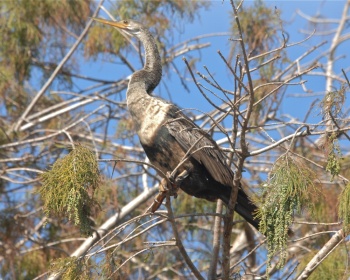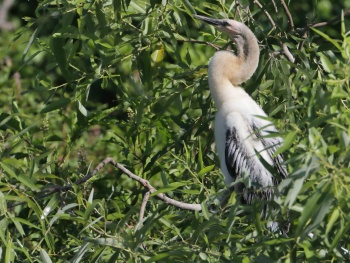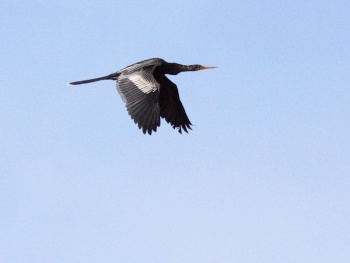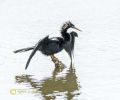- Anhinga redirects here. For the genus Anhinga, see Anhinga
- Anhinga anhinga
Identification
L. 35" (89 cm); Ws. 45" (114 cm)
- Slender
- Dark body
- Long tail and neck
Male:
- Jet black with green iridescence
- Dramatic silver and white markings on upper back and forewings
- Long, sharp yellow bill
- Red eyes with blue skin
Female:
- Dark brown overall
- Lighter brown head, neck, and breast
Distribution
In the U.S., it is found along and well inland from the Gulf of Mexico to Florida and along the east coast north to at least Virginia. Northernmost birds are at least partially migratory, moving southwards in winter.
It is also found along a narrow strip on the southwest coast of Mexico, in Cuba (vagrant in the rest of the Caribbean), and in Central and South America from Guatemala, Belize and Trinidad and Tobago south to Argentina (but not Chile).
Taxonomy
Subspecies
Two subspecies are recognized[1]:
- A. a. leucogaster:
- A. a. anhinga:
- Trinidad, Tobago and northern South America to northern Argentina
Habitat
Freshwater ponds, lakes, and marshes.
Behaviour
Actions
Dives frequently for fish, which it spears with its long sharp bill, then tosses them in the air until it can swallow them headfirst.
The colloquial name, Snakebird, can be quite descriptive when this bird is in the water - it swims with its body mostly submerged, and just the long sinuous neck above. On quick glance, it can thus appear to be a swimming snake. The other common posture is on a tree near or over water, where it spends hours with wings extended, drying in the sun; unlike ducks, it has no oil with which to waterproof its feathers, an adaptation to improve its diving ability.
Diet
Their diet consists mostly of fish, with the addition of frogs, newts, salamanders, crayfish and even snakes appearing on the menu.
Breeding
Monogamous. They often breed colonially and sometimes with Cormorants. Nests are almost always placed over water, 1-3 m above. These are stick structures, usually with green leaves and branches built in. They often lay between 2-5 eggs. Presumably incubation starts with the first egg (both parents participate) and it takes almost a month for the young to hatch. It takes a further 6 weeks before the first flight it attempted. However, after only two weeks a young which is disturbed will jump into the water and later climb back up to the nest.
Gallery
Click on photo for larger image
Drying Out
Photo © by STEFFRO1
Huntington Beach State Park, South Carolina, USA, 22 May 2019
References
- Clements, J. F., T. S. Schulenberg, M. J. Iliff, T. A. Fredericks, J. A. Gerbracht, D. Lepage, S. M. Billerman, B. L. Sullivan, and C. L. Wood. 2022. The eBird/Clements checklist of Birds of the World: v2022. Downloaded from https://www.birds.cornell.edu/clementschecklist/download/
- Orta, J., Garcia, E.F.J., Kirwan, G.M. & Boesman, P. (2019). Anhinga (Anhinga anhinga). In: del Hoyo, J., Elliott, A., Sargatal, J., Christie, D.A. & de Juana, E. (eds.). Handbook of the Birds of the World Alive. Lynx Edicions, Barcelona. (retrieved from https://www.hbw.com/node/52665 on 19 August 2019).
- Frederick, P. C. and D. Siegel-Causey (2020). Anhinga (Anhinga anhinga), version 1.0. In Birds of the World (A. F. Poole and F. B. Gill, Editors). Cornell Lab of Ornithology, Ithaca, NY, USA. https://doi.org/10.2173/bow.anhing.01
- Arthur Grosset's Birds
Recommended Citation
- BirdForum Opus contributors. (2024) Anhinga. In: BirdForum, the forum for wild birds and birding. Retrieved 17 May 2024 from https://www.birdforum.net/opus/Anhinga
External Links
- Anhinga USGS Patuxent Wildlife Research Center
GSearch checked for 2020 platform.1










